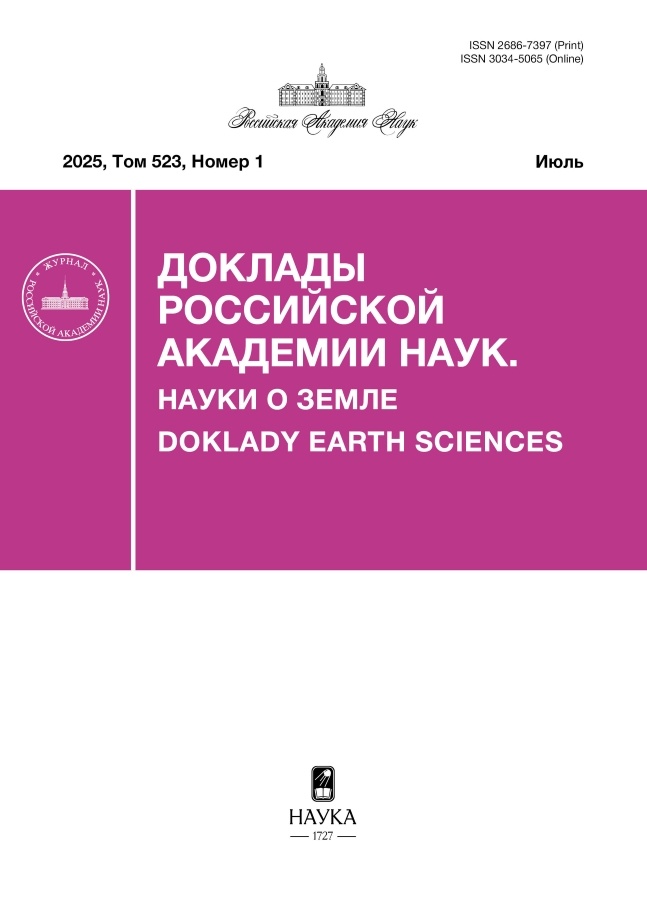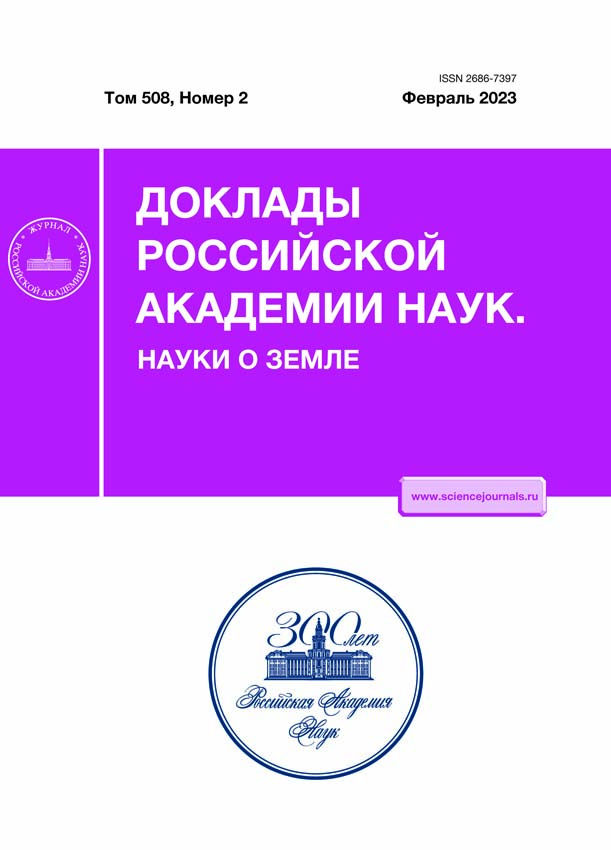Изотопная система кислорода лейкогранитов Омсукчанского прогиба (СВ России): условия и механизмы взаимодействия флюид–порода
- Авторы: Дубинина Е.О.1, Филимонова Л.Г.1, Авдеенко А.С.1, Чижова Ю.Н.1, Коссова С.А.1, Жиличева О.М.1, Аранович Л.Я.1
-
Учреждения:
- Институт геологии рудных месторождений, петрографии, минералогии и геохимии Российской академии наук
- Выпуск: Том 508, № 2 (2023)
- Страницы: 203-210
- Раздел: ГЕОХИМИЯ
- Статья получена: 30.01.2025
- Статья опубликована: 01.02.2023
- URL: https://cijournal.ru/2686-7397/article/view/649723
- DOI: https://doi.org/10.31857/S2686739722602046
- EDN: https://elibrary.ru/SVLUDS
- ID: 649723
Цитировать
Полный текст
Аннотация
Изучен изотопный состав кислорода минералов (Qtz, Zrn, Kfs) и валовых проб позднемеловых порфировых лейкогранитов Омсукчанского прогиба и прилегающих территорий, в пределах которых развито Au–Ag-, Sn- и Sn-полиметаллическое оруденение. Величины δ18О валовых проб лейкогранитов возрастают от –10.6‰ в районе Дукатского Au–Ag-рудного поля до +9.7‰ в районе других рудоносных областей. Изотопно-легкие характеристики пород являются атрибутом полевых шпатов и отвечают изотопному равновесию с флюидом метеорного происхождения (δ18О = –15‰) в широком интервале Т при ограниченных соотношениях флюид–порода (W/R от 0.9–1.6 до 0.3–0.1). Величины δ18О кварца и циркона также изменены в процессе флюидного воздействия, но частично: в первом случае, вероятно, по механизму диффузии, а во втором – по механизму растворения-кристаллизации.
Об авторах
Е. О. Дубинина
Институт геологии рудных месторождений, петрографии, минералогии и геохимииРоссийской академии наук
Автор, ответственный за переписку.
Email: elenadelta@gmail.com
Россия, Москва
Л. Г. Филимонова
Институт геологии рудных месторождений, петрографии, минералогии и геохимииРоссийской академии наук
Email: elenadelta@gmail.com
Россия, Москва
А. С. Авдеенко
Институт геологии рудных месторождений, петрографии, минералогии и геохимииРоссийской академии наук
Email: elenadelta@gmail.com
Россия, Москва
Ю. Н. Чижова
Институт геологии рудных месторождений, петрографии, минералогии и геохимииРоссийской академии наук
Email: elenadelta@gmail.com
Россия, Москва
С. А. Коссова
Институт геологии рудных месторождений, петрографии, минералогии и геохимииРоссийской академии наук
Email: elenadelta@gmail.com
Россия, Москва
О. М. Жиличева
Институт геологии рудных месторождений, петрографии, минералогии и геохимииРоссийской академии наук
Email: elenadelta@gmail.com
Россия, Москва
Л. Я. Аранович
Институт геологии рудных месторождений, петрографии, минералогии и геохимииРоссийской академии наук
Email: elenadelta@gmail.com
Россия, Москва
Список литературы
- Farver J.R. Oxygen and Hydrogen Diffusion in Minerals // Rev. Mineral. Geochem. 2010. V. 72. P. 447–507.
- Harris C., Faure K., Diamond R.E., Scheepers R. Oxygen and hydrogen isotope geochemistry of S-and I-type granitoids: the Cape Granite suite, South Africa // Chemical Geology. 1997. V. 143 P. 95–114.
- Jenkin G.R.T., Farrow C.M., Fallic A.E., Higgins D. Oxygen isotope exchange and closure temperatures in cooling rocks // Journal of Metamorphic Geology. 1994. V. 12. P. 221–215.
- Watson E.B., Cherniak D.J. Oxygen diffusion in zircon // Earth and Planetary Science Letters. 1997. V. 148. P. 527–544.
- Chen W.T., Zhou M.-F. Hydrothermal alteration of magmatic zircon related to NaCl-rich brines: diffusion-reaction and dissolution-precipitation processes // American Journal of Science. 2017. V. 317. P. 177–215.
- Аранович Л.Я., Бортников Н.С., Зингер Т.Ф. и др. Морфология и элементы-примеси циркона из океанической литосферы осевой зоны САХ (6°–13°с.ш.): свидетельства особенностей магматической кристаллизации и постмагматических преобразований // Петрология. 2017. Т. 25. № 4. С. 335–361.
- Константинов М.М., Наталенко В.Е., Калинин А.И. и др. Золотосеребряное месторождение Дукат. М.: Недра, 1998. 202 с.
- Банникова Л.А. Органическое вещество в гидротермальном рудообразовании. М: Наука, 1990. 207 с.
- Дубинина Е.О., Филимонова Л.Г., Коссова С.А. Изотопные (δ34S, δ13C, δ18O) характеристики вкрапленной минерализации магматических пород Дукатского рудного поля (Северо-Восток России) // Геология рудных месторождений. 2019. Т. 61. № 1. С. 39–51.
- Стружков С.Ф., Константинов М.М. Металлогения золота и серебра Охотско-Чукотского вулканогенного пояса. М.: Научный мир, 2005. 318 с.
- Акинин В.В., Биндеман И. Н. Вариации изотопного состава кислорода в магмах Охотско Чукотского вулканогенного пояса // ДАН. 2021. Т. 499. № 1. С. 26–32.
- Котляр И.Н., Русакова Т.Б., Гагиева А.М. Буюндино-Сугойская рудоконцентрирующая площадь: уникальный металлогенический ареал Северо-Востока России // Тихоокеанская геология. 2004. Т. 23. № 1. С. 3–19.
- Valley J.W. Oxygen isotopes in zircon. In: Hanchar, J.M., Hoskin, P.W. O. (Eds.), Zircon. / Reviews in Mineralogy and Geochemistry. 2003. V. 53. P. 343–385.
- Wei C.-S., Zi-Fu Zhao, Spicuzza M.J. Zircon oxygen isotopic constraint on the sources of late Mesozoic A-type granites in eastern China // Chemical Geology. 2008. V. 250. P. 1–15.
- Taylor H.P., Sheppard S.M-F. Igneous rocks: I. Processes of isotopic fractionation and isotope systematics// Reviews in Mineralogy and Geochemistry. 1986. V. 16. P. 227–272.
- Челноков Г.А., Брагин И.В., Харитонова Н.А. Новые изотопно-геохимические данные по Таватумским термальным водам (Магаданская область) // Тихоокеанская геология. 2021. Т. 40. № 5. С. 104–114.
- Dennis P.F. Oxygen self-diffusion in quartz under hydrothermal conditions // Journal of Geophysical Research. 1984. V. 89. P. 4047–4057.
- Zhao Zi-Fu, Yong-Fei Zheng. Calculation of oxygen isotope fractionation in magmatic rocks // Chemical Geology. 2003. V. 193. P. 59–80.
- Vho A., Lanari P., Rubatto D. An internally-consistent database for oxygen isotope fractionation between minerals // Journal of Petrology. 2020. https://doi.org/10.1093/petrology.egaa001
- Zheng Y.F., Gong B., Zhao Z.F., Wu Y.B., Chen F.K. Zircon U-Pb age and O isotope evidence for Neoproterozoic low-18O magmatism during Supercontinental rifting in South China: implications for the snowball Earth event // American Journal of Science. 2008. V. 308. P. 484–516.
Дополнительные файлы















